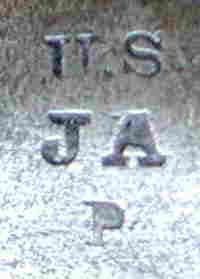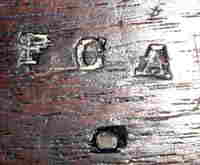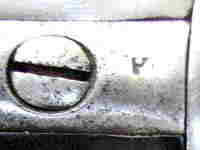|
|
|||||||
|
|
|||||||
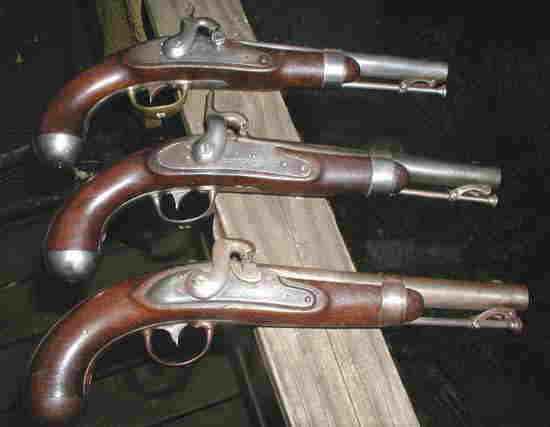
|
|||||||
|
Center: Undated Early Production, A. H. Waters "Flat Lock" Percussion Pistol. Bottom: 1842 Dated U.S. Model 1836 A. Waters Pistol Converted from Flint Lock to Percussion.
|
|||||||
|
|
|||||||
|
|
|||||||
|
|
|||||||
|
The U. S. Model 1836 Asa Waters Flintlock Pistol was the last of the
U.S. martial flintlock pistols. It is considered by some to be the
finest military flintlock ever produced. It was trim, well balanced
and exhibited fine workmanship. Of the 41,000 made, the majority were
converted to percussion in the 1850's. The conversion seen here is
known as the "French Style" or first U.S. type. All external flintlock
parts were removed, the pan cut nearly flush with the lockplate and
a drum, into which a cone is seated, was threaded into the enlarged
touch-hole or vent. The old pan was milled away into a semi-circular
shape and used to bolster the drum unit. The "Belgium" alteration
or the second U. S. type altered the lockplate also, but in lieu of
using a side drum, a new orifice was drilled into the upper right
of the barrel for a cone or nipple seat which was then threaded into
place.
|
|||||||
|
These conversions were stocked in both U.S. and State arsenals at
the outbreak of the Civil War and many were liberated by the Confederacy
from the southern U.S. arsenals. In the opening months of the war,
these pistols were issued as conditions dictated by both sides. It
is suspected that some of them spent the war in the stocks of both
Union and Confederate navy ships. After all, they made excellent 'boarding"
pistols as you could load them with anything including nails!
|
|||||||
|
|
|||||||
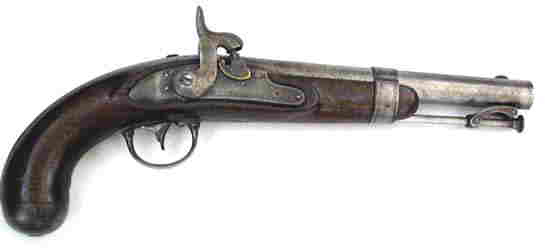
|
|||||||
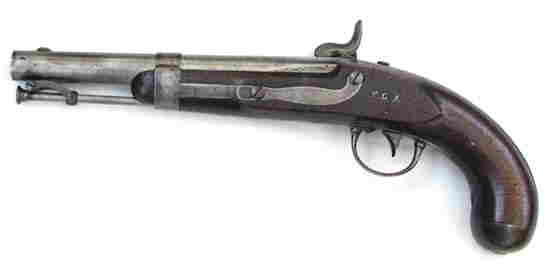
|
|||||||

|

|
||||||
|
|
|||||||
|
|
|||||||
|
This pistol, unlike the following "Flat Lock" percussion pistols also
made by Waters, has a full complement of U.S. and inspector markings.
They are as follows:
|
|||||||
|
|||||||
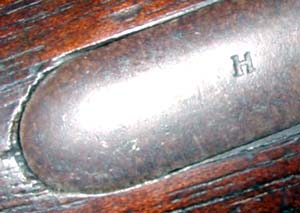
H |

U |
||||||
| H
Proof on forward end of trigger guard strap
|
U
Proof at bottom rear of trigger guard strap
|
||||||
|
|
|||||||
|
a.k.a. Waters "Flat Lock" Pistols
|
|||||||
|
An unknown quantity of these guns were made by A. H. Waters and Company
from the mid 1840's to 1849. The one dated 1844 has the side lug holding
the nipple and the rear oval shaped sight on the tang. It also has
a brass trigger guard bow. All other furniture is iron. There are
no U.S. markings either on the barrel or lockplate. It has a brass
blade front sight. The one with the nipple set into the barrel is
not dated. There are no U.S. markings on this pistol either. The barrel
is also unmarked and there is no rear sight. The front sight is a
brass blade. All furniture is iron. Both pistols have the flat lockplate.
Both pistols have an eagle head stamped on the lockplate. The converted
Model 1836, above, did not.
|
|||||||
|
It is unknown why these models were made. Some suggest that they were
"transitional" models between the last flintlock pistol (The Model
1836) and the first adopted percussion handgun (The Model 1842). Others
think that it was the maker's attempt to obtain additional government
contracts. They were definitely made as percussion weapons and their
most easily telling feature is the flat, flush fitted lockplate. There
are several known variations. Existing specimens indicate a definite
transitional and development period which included variations in the
lockplates and some experimentation by the Waters armory. According
to Riley, the Belgium, or cone-in-barrel percussion ignition system
was the earliest of these pistols and only a few specimens exist.
|
|||||||
|
Although they resemble the Model 1836 flintlock pistol and appear
to be percussion alterations of this arm, it should be noted that
these pistols were originally produced in percussion form. It is my
opinion that these pistols did include some surplus parts from the
Model 1836. Since there are no stock markings on these pistols and
that no government contracts, purchases or records pertaining to these
pistols are known, it is unlikely that any were purchased by the federal
government. Asa Holman Waters may well have sold some of these pistols
to state militia units and those arms may have see martial usage but
as far as can be determined, no definite proof of this exists. They
are originals by birth that have been made mysteries by history.
|
|||||||
|
|
|||||||
|
The photographic evidence follows:
|
|||||||
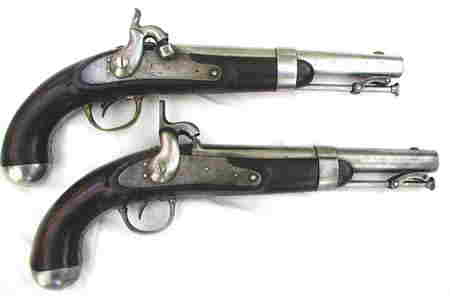
|
|||||||
|
Bottom - Both Pics: Undated Early Production, A.H. Waters "Flat Lock" Percussion Pistol.
|
|||||||

|

|
||||||
|
Bottom - Both Pics: 1844 Dated Pistol
|
|||||||
|
Both pistols are .54 caliber, smoothbore, have overall lengths
of 14½" with barrels of 8-7/16" from muzzle to breech. The
tang on the 1844 is 1-9/16" and the lockplate is 4-9/16" long. The
tang on the undated pistol is 1½" and the lockplate is 4½"
long.
|
|||||||
|
|
|||||||
|
The "flat lock" Waters pistol dated 1844 is marked as follows:
|
|||||||
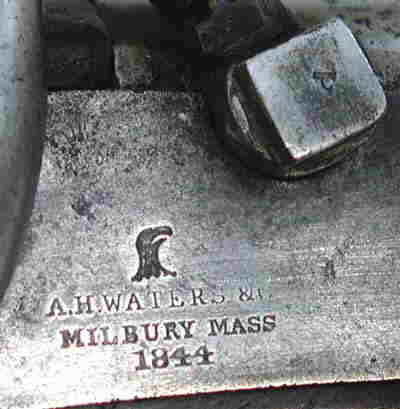
(Eagle Head Stamp) A.H. WATERS & Co MILBURY MASS 1844 |
|||||||
|
|
|||||||
|
|||||||
|
|
|||||||
|
The markings on the Waters "Flat Lock" undated, early production pistol
follow:
|
|||||||
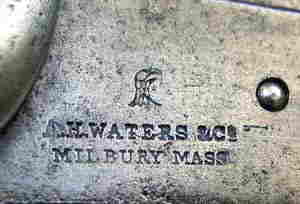
(Eagle Head Stamp) A. H. WATERS & Co MILBURY MASS |
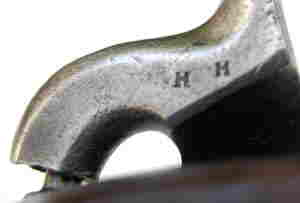
HH |
||||||
|
|
|
||||||
|
|
|||||||
|
The references used in this posting, sometimes verbatim, were United
States Military Small Arms, 1816-1865 by Robert M. Reilly and
Flayderman's Guide To Antique American Firearms...and their values
by Norm Flayderman.
|
|||||||
|
My son and webmaster, Reed Radcliffe, a retired U.S.N. CPO,
deserves all the credit for posting this information to my web page.
We both sincerely hope you enjoyed this one and the others before
it, and will enjoy those to come.
|
|||||||
| Dave
Radcliffe
|
|||||||

